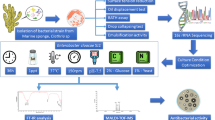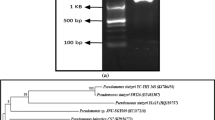Abstract
Nocardia otitidiscaviarum microbial type cultural collection 6471 isolated from oil contaminated Alang India seawater was examined for production of surface active compound. Isolate shows halos and α-heamolysis on cetyl trimethyl ammonium bromide and blood agar respectively indicating the production of biosurfactant. Biosurfactant was extracted by precipitation and was partially purified. Partially purified product was characterized by thin layer chromatography and Infra-red spectroscopy and was identified as glycolipid. Sugar present in glycolipid was rhamnose and hence, biosurfactant was quantified as rhamnose equivalent. Role of cell-surface hydrophobicity and emulsification activity in correlation with biosurfactant production was examined. Correlation between biosurfactant production, growth and crude oil degradation was also examined and showed positive correlation at significant level 0.001 and 0.01 respectively. Thus, this is a first report on a marine strain of Nocardia otitidiscaviarum microbial type culture collection 6471, which can be a potential candidate for restoration of oil contaminated marine environment.
Similar content being viewed by others
References
Adams, R. H.; Guzman-Osorio, F. J.; Zavala Cruz, J., (2008). Water repellency in oil contaminated sandy and clayey soils. Int. J. Environ. Sci. Tech., 5(4), 445–454 (10 pages).
Alexander, M., (1999). Biodegradation and Bioremediation. 2nd Ed. Academic Press, San Diego.
Al-Tahhan, A.; Sandrin, T. R.; Bodour, A. A.; Maier, R., (2000). Rhamnolipid-induced removal of lipopolysac-charide from Pseudomonas aeruginosa: effect on cell surface properties and interaction with hydrophobic substrates., Appl. Environ. Microbiol., 66, 3262–3268 (7 pages).
Atlas, R. M.; Bartha, R., (1992). Hydrocarbon biodegradation and oil spill bioremediation, in: Marshall, K. C., (Ed), Advances in Microbial Ecology. Plenum Press, New York, 287–338 (52 pages).
Banat, I. M., (1993). The isolation of thermophilic biosurfactant producing Bacillus species. Biotech. Letter, 15, 591–594 (4 pages).
Beal, R.; Betts, W. B., (2000). Role of rhamnolipid biosurfactants in the uptake and mineralization of hexadecane in Pseudomonas aeruginosa. J. Appl. Microbiol., 89, 158–168 (11 pages).
Bonin, P.; Ranaivoson, E. R.; Raymond, N.; Chalamet, A.; Bertrand, J. C., (1994). Evidence for denitrification in marine sediment highly contaminated by petroleum products. Marine Poll. Bull., 28, 89–95 (7 pages).
Bredholt, H.; Bruheim, P.; Potocky, M.; Eimhjellen, K., (2002). Hydrophobicity development, alkane oxidation and crude oil emulsification in Rhodococcus species. Can. J. Microbiol., 48, 295–304 (10 pages).
Chandrasekharan, E. V.; BeMiller, J. N., (1980). Constituent analysis of glycosaminoglycans. in: Whistler, R. L., (Ed), Methods in Carbohydrates Chemistry. Academic Press, NY, USA, 8, 95–96 (2 pages).
Cho, J-H.; Jeong, Y-L.; Park, O-J.; Yoon, B-D.; Yang, J. W., (1998). Characterization of glycolipid biosurfactants from an isolated strain of Pseudomonas aeruginosa YPJ 80. J. Microbiol. Biotech., 86(6), 645–649 (5 pages).
Cooper, D. G.; Goldenberg, B. G., (1987). Surface-active agents from two Bacillus species. Appl. Environ. Microbiol., 53, 224–229 (6 pages).
Desai, A. J.; Patel, R.; Desai, J. D., (1994). Advances in production of biosurfactants and their commercial applications. J. Sci. Indus. Res., 53, 619–629 (11 pages).
Fiechter, A., (1992). Biosurfactants: moving towards industrial application. Trends in Biotech., 10, 208–217 (10 pages).
Francy, D. S.; Thomas, J. M.; Raymond, R. L.; Ward, C. H., (1991). Emulsification of hydrocarbons by subsurface bacteria. J. Indus. Microbiol., 8, 237–246 (10 pages).
Goyal, P.; Sharma, P.; Srivastava, S.; Srivastava, M. M., (2008). Saraca indica leaf powder for decontamination of Pb: Removal, recovery, adsorbent characterization and equilibrium modeling. Int. J. Environ. Sci. Tech. 5(1), 27–34 (8 pages).
Grassoff, K.; Kermling, K.; Ehrhardt, M., (1976). Methods of Seawater Analysis, Verlag Chemie, Weinbein.
Haghighat, S.; Akhavan Sepahy, A.; Mazaheri Assadi, M.; Pasdar, H., (2008), Ability of indigenous Bacillus licheniformis and Bacillus subtilis in microbial enhanced oil recovery, Int. J. Environ. Sci. Tech., 5, 385–390 (6 pages).
Husseien, M.; Amer, A. A.; El-Maghraby, A.; Taha, N. A., (2009).Availability of barley straw application on oil spill clean up. Int. J. Environ. Sci. Tech., 6(1), 123–130 (8 pages).
Johnson, M. K.; Boese-Marrazzo, D., (1980). Production and properties of heat-stable extracellular hemolysin from Pseudomonas aeruginosa. Infect Immun., 29(3), 1028–1033 (6 pages).
Juang, D. F.; Yuan, C. S.; Hsueh, S. C.; Chiou, L. J., (2009a). Distribution of volatile organic compounds around a polluted river. Int. J. Environ. Sci. Tech., 6(1), 91–104 (14 pages).
Juang, D. F. Lee, C. H.; Hsueh, S. C., (2009b). Chlorinated volatile organic compounds found near the water surface of heavily polluted rivers. Int. J. Environ. Sci. Tech., 6(4), 545–556 (12 pages).
Kosamu, I. B. M.; Obst, M., (2009). The influence of picocyanobacterial photosynthesis on calcite precipitation. Int. J. Environ. Sci. Tech., 6(4), 557–562 (6 pages).
Lisboa, B. P., (1964). Characterization of Δ4-3-OXO-C21-steroids on thin-layer chromatograms by “in situ” colour reactions. J. Chromat., 16, 136–151 (15 pages).
Nagheeby, M.; Kolahdoozan, M., (2010). Numerical modeling of two-phase fluid flow and oil slick transport in estuarine water. Int. J. Environ. Sci. Tech., 7(4), 771–784 (8 pages).
Oberbremer, A.; Muller-Hurtig, R.; Wagner, F., (1990). Effect of the addition of microbial surfactants on hydrocarbon degradation in soil population in a stirred reactor. Appl. Microbiol. Biotech., 32, 485–489 (5 pages).
Panagoda, G. J.; Ellepola, A. N.; Samaranayake, L. P., (2001). Adhesion of Candida parapsilosis to epithelial and acrylic surfaces correlates with cell surface hydrophobicity. Mycoses, 44, 29–35 (7 pages).
Prabhu, Y.; Phale, P. S., (2003) Biodegradation of phenanthrene by Pseudomonas sp. strain PP2: novel metabolic pathway, role of biosurfactant and cell surface hydrophobicity in hydrocarbon assimilation, Appl. Microbiol. Biotech., 61, 342–351 (10 pages).
Rosenberg, M.; Gutnick, D. L.; Rosenberg, E., (1980). Adherence of bacteria to hydrocarbons: a simple method for measuring cell-surface hydrophobicity. FEMS Microbiol. Letters, 9, 29–33 (5 pages).
Siegmund, I.; Wagner, F., (1991). New method for detecting rhamnolipids excreted by Pseudomonas species during growth on mineral agar. Biotech. Tech., 5, 265–268 (4 pages).
Singleton, D. R.; Furlong M. A.; Rathbun, S. L.; Whitman, W. B., (2001). Quantitative comparisons of 16S rRNA gene sequence libraries from environmental samples. Appl. Environ. Microbiol., 67, 4374–4376 (3 pages).
Stahl, E., (1969). Thin-Layer Chromatography. Springer Verlag, New York.
Vyas, T. K.; Dave, B. P., (2007). Effect of crude oil concentrations, temperature and pH on growth and degradation of crude oil by marine bacteria. Indian J. Marine Sci., 36(1), 76–85 (10 pages).
Vyas, T. K.; Dave, B. P., (2010). Effect of addition of nitrogen, phosphorus and potassium fertilizers on biodegradation of crude oil by marine bacteria. Indian J. Marine Sci., 39(1), 143–150 (8 pages).
Zhang, Y.; Miller, R. M., (1992). Enhanced octadecane dispersion and biodegradation by a Pseudomonas rhamnolipid surfactant (biosurfactant). Appl. Environ. Microbiol., 58, 3276–3282 (7 pages).
Zobell, C. E., (1946). Action of microorganisms on hydrocarbons. Bacteriol. Rev., 10, 1–49 (49 pages).
Author information
Authors and Affiliations
Corresponding author
Rights and permissions
About this article
Cite this article
Vyas, T.K., Dave, B.P. Production of biosurfactant by Nocardia otitidiscaviarum and its role in biodegradation of crude oil. Int. J. Environ. Sci. Technol. 8, 425–432 (2011). https://doi.org/10.1007/BF03326229
Received:
Revised:
Accepted:
Published:
Issue Date:
DOI: https://doi.org/10.1007/BF03326229




